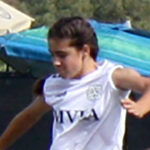The certainty of fatigue: Recognizing and avoiding overtraining
\r\n\r\nSo we\u2019re starting to paint a picture of how amazing muscle mechanics are \u2013 that the joint can survive and function even when one of its components has reached the limit.\u00a0 But the act of survival has the side effect of compromising other joints, inevitably creating movement compensations. When support muscles step up to take on the task of failing primary muscles, their own primary motives become compromised as well.\r\n\r\nIn this way, the best athletes are also the best compensators. Because fatigue will eventually occur, the athlete needs solutions other than the most preferred mechanical options to operate at a high level. My job as a muscle function specialist (Muscle Activation Techniques\u2122 Specialist) is to make all the best options for compensation available to the athlete by optimizing how their muscles detect and communicate between one another.\r\n\r\nA fine line exists between expected fatigue and chronic fatigue. That line is quietly crossed when bad habits like an unbalanced diet or lack of sleep and appropriate exercise happen consistently.\r\n\r\nThe amount of expected fatigue varies according to the athlete\u2019s state of health and fitness prior to competing or training. Some of the most prevalent limiting factors to performance are hydration, available energy stores and the individual capabilities of soft tissues and muscles in a pre-stress state.\r\n\r\nWe can compete in less than optimal conditions, but we can\u2019t do it repeatedly. Herein lies my uphill battle: Most people, and especially athletes, don\u2019t know how it feels to be well-rested and functioning at an optimal level \u2013 we are at odds with ourselves in being aware of all the small fatigues that sum to chronic fatigue.\r\n\r\nMuscle fatigue through a tough training session or a high-intensity game is expected and an athlete can recover fairly easily with proper nutrition, hydration and rest. But if regeneration doesn\u2019t occur once or even a few times, a delicate balance is thrown off \u2013 muscles become inhibited and their endocrine system will become overstressed. Allowing your muscles to reach this state multiple times will quickly result in low energy, tight muscles, emotional stress, a compromised immune system, tendonitis and\/or ligaments. This is not a \u201cmaybe,\u201d this is for sure.\r\n\r\nFear not! Solutions to these problems come in the form of vigilance and education. Questions concerning optimal health and performance have no pre-packaged solution. One of the simplest and best solutions to this equation is getting adequate sleep. A study conducted by the American Academy of Pediatrics concluded that the risk of injury in teens in grades 7-12 was decreased by 68% when they slept eight or more hours, consistently(Milewski, 2012).\r\n\r\nConclusion<\/strong>\r\n\r\nThink of the body\u2019s homeostasis as an equalization process: It is fluid and dynamic, functioning as an open system without anything to isolate it from the surrounding environment. The needle of our homeostatic gauge is trying to keep steady in constantly changing surroundings \u2013 balancing temperature, work load, stress, energy, and several other external variables.\r\n\r\nWhen it comes to the health and well-being of our athletes, learning and questioning will guide us towards controlling an excess of, and the harmful effects of physical stress. Should you choose to ignore the body\u2019s warning signs, letting them add up day after day, you\u2019d be thoughtlessly reinforcing negligent behavior that magnifies smaller issues of fatigue into chronic problems. The year-round soccer player will have to be vigilant \u2013 avoiding inadequacies in sleep, micro\/macro nutrition, as well as physical and mental workloads \u2013 ensuring peak performance no matter what they encounter on the pitch.\r\n\r\nAs both a coach and biomechanics consultant, I find one of the best ways to balance the homeostatic equation is through increasing muscular capacity in strength training. There is no such thing as over-educating yourself, and seeking the advice of nutrition and mental regeneration experts is another way of keeping on top of your game. In sum, I find the best approach to keeping chronic fatigue at bay is not one of absolutes, but one of adaptation.\r\n\r\nWorks Cited<\/strong><\/em>\r\n\r\nPurvis, T. (2008).\u00a0 Resistance Training Specialist Science 1 Manual. (chapter 5, p.5)\u00a0 Oklahoma City, OK.\r\n\r\nKandel, E., Schwartz, J., Jessell, T. (2012) Principals of Neural Science. New York, NY. McGraw-Hill\r\n\r\nMilewski, M., (October 2012).\u00a0 Lack of Sleep is Associated with Increased Risk of Injury in Adolescent Athletes.\u00a0 American Academy of Pediatrics\r\n\r\n[\u00a0+Visit the Impact Fitness website to learn more<\/a>\u00a0]”},”name”:”acf\/wysiwyg”,”mode”:”edit”} /–>
SOCCERWIRE MARKETPLACE
- Wanted Licensed Youth Soccer Coach
- Join Official Elite Summer Soccer Camps with Europe’s Top Pro Clubs!
- The St. James FC Travel Staff Coach - North (Loudoun) & South (Fairfax)
- The St. James FC Girls Academy (GA) Head Coach - 2 teams
- The St James FC Boys Travel Tryouts
- OFFICIAL BAYERN MUNICH SUMMER CAMPS U.S.
- JOIN THE ALLIANCE!
- OFFICIAL FC BARCELONA CAMPS U.S.
- The Cup San Diego - Hosted by Legends FC
- Players Wanted - Undergraduate or Post-graduate











